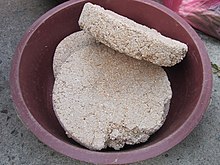
Nuruk (Korean: 누룩) is a traditional Korean fermentation starter.[1][2][3][4] It is used to make various types of Korean alcoholic beverages including takju, cheongju, and soju.[3][5] It is an essential ingredient in Shindari and is mixed with rice.[6] Historically, it was used in a variety of provinces of Korea, including Jeju Island.
Wheat, rice (of both the glutinous and non-glutinous types), and barley are used to make nuruk, either as whole grain or in the form of grits or flour.[2][7] Wheat nuruk is the most common variety. The dry grain is moistened, shaped into a large cake, and hung up to ferment for 2‒4 weeks in an ondol room.[2][3][7] The cake matures at a precise temperature until a mold forms.[3]
- ^ "Fermented Cereals a Global Perspective. Chapter 3." Fermented Cereals a Global Perspective. Chapter 3. Web. 04 Mar. 2016.
- ^ a b c Lee, Cherl-Ho (1999). "Cereal Fermentations in Countries of the Asia-Pacific Region". In Haard, Norman F.; Odunfa, S.A.; Lee, Cherl-Ho; Quintero-Ramírez, R.; Lorence-Quiñones, Argelia; Wacher-Radarte, Carmen (eds.). Fermented cereals : a global perspective. FAO Agricultural Services Bulletin. Rome: Food and Agriculture Organization. p. 91. ISBN 92-5-104296-9. ISSN 1010-1365. Retrieved 19 June 2017.
- ^ a b c d Shin, Dong-Hwa; Kim, Young-Myoung; Park, Wan-Soo; Kim, Jae-Ho (2016). "Ethnic Fermented Foods and Beverages of Korea". In Tamang, Jyoti Prakash (ed.). Ethnic Fermented Foods and Alcoholic Beverages of Asia. India: Springer. p. 298. ISBN 9788132228004. Retrieved 23 September 2017.
- ^ McKay, Marianne; Buglass, Alan J.; Lee, Chang Gook (2011). "Fermented Beverages: Beers, Ciders, Wines and Related Drinks". In Buglass, Alan J. (ed.). Handbook of Alcoholic Beverages: Technical, Analytical and Nutritional Aspects. Chichester, UK: Wiley. pp. 214–216. ISBN 978-0-470-51202-9. Retrieved 23 September 2017.
- ^ Yoo, Jong-Gil. Nuruk, a Traditional Korean Fermentation Starter, contains the Bioactive Compound 2,6-dimethoxy-1,4-benzoquinone (2,6-DMBQ). Online.
- ^ Nowicki, Stephen. Holt McDougal Biology. Orlando, FL: Holt McDougal, 2012. Print.
- ^ a b Yokotsuka, T. (1985). "Fermented protein foods in the Orient, with emphasis on shoyu and miso in Japan". In Wood, Brian J. B. (ed.). Microbiology of Fermented Foods. Vol. 1. London: Elsevier Applied Science Publishers. pp. 197–247. ISBN 978-1-4613-7990-4.
